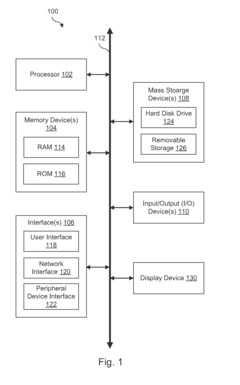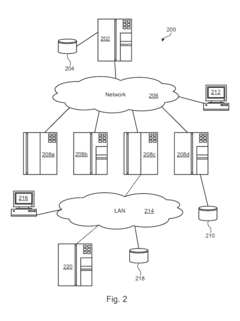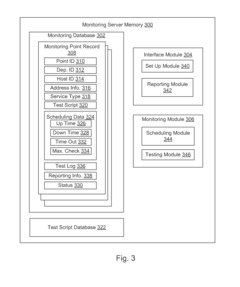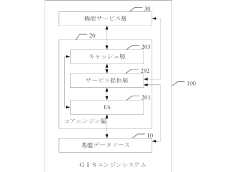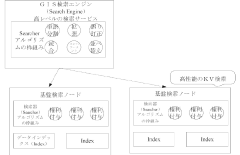The Role of GIS in 454 Big Block Performance Monitoring
AUG 12, 20259 MIN READ
Generate Your Research Report Instantly with AI Agent
Patsnap Eureka helps you evaluate technical feasibility & market potential.
GIS in 454 Big Block: Background and Objectives
Geographic Information Systems (GIS) have revolutionized the way industries monitor and analyze complex systems, and their application in 454 Big Block performance monitoring represents a significant technological advancement. The 454 Big Block, a high-performance engine known for its power and efficiency, requires sophisticated monitoring tools to ensure optimal operation and maintenance.
The development of GIS technology can be traced back to the 1960s, but its integration with engine performance monitoring is a more recent innovation. As computing power and data processing capabilities have increased, GIS has evolved from simple mapping tools to complex analytical systems capable of handling vast amounts of real-time data.
In the context of 454 Big Block performance monitoring, GIS serves as a crucial interface between raw engine data and actionable insights. By incorporating spatial and temporal dimensions into performance analysis, GIS enables engineers and technicians to visualize and interpret engine behavior in unprecedented ways. This technology allows for the creation of detailed performance maps, highlighting variations in engine output across different operating conditions and geographical locations.
The primary objective of implementing GIS in 454 Big Block monitoring is to enhance engine efficiency, reliability, and longevity. By providing a comprehensive view of engine performance, GIS helps identify patterns and anomalies that might otherwise go unnoticed. This proactive approach to engine management can lead to significant improvements in fuel economy, reduced emissions, and extended engine life.
Another key goal is to optimize maintenance schedules and reduce downtime. GIS-based monitoring systems can predict potential failures before they occur by analyzing historical data and identifying trends. This predictive maintenance capability is particularly valuable for industries relying on 454 Big Block engines, such as transportation, construction, and power generation.
Furthermore, GIS integration aims to improve decision-making processes related to engine deployment and operation. By considering geographical factors such as altitude, temperature, and humidity, operators can make informed choices about engine settings and performance expectations in various environments. This level of insight is invaluable for maximizing engine efficiency across diverse operating conditions.
As environmental regulations become increasingly stringent, the role of GIS in monitoring and reducing emissions from 454 Big Block engines has gained prominence. The technology enables precise tracking of emissions data, allowing for real-time adjustments to minimize environmental impact while maintaining performance standards.
Looking ahead, the integration of GIS with emerging technologies such as artificial intelligence and machine learning presents exciting possibilities for further advancements in engine performance monitoring. These developments promise to push the boundaries of what's possible in terms of engine optimization and predictive maintenance, setting new standards for the industry.
The development of GIS technology can be traced back to the 1960s, but its integration with engine performance monitoring is a more recent innovation. As computing power and data processing capabilities have increased, GIS has evolved from simple mapping tools to complex analytical systems capable of handling vast amounts of real-time data.
In the context of 454 Big Block performance monitoring, GIS serves as a crucial interface between raw engine data and actionable insights. By incorporating spatial and temporal dimensions into performance analysis, GIS enables engineers and technicians to visualize and interpret engine behavior in unprecedented ways. This technology allows for the creation of detailed performance maps, highlighting variations in engine output across different operating conditions and geographical locations.
The primary objective of implementing GIS in 454 Big Block monitoring is to enhance engine efficiency, reliability, and longevity. By providing a comprehensive view of engine performance, GIS helps identify patterns and anomalies that might otherwise go unnoticed. This proactive approach to engine management can lead to significant improvements in fuel economy, reduced emissions, and extended engine life.
Another key goal is to optimize maintenance schedules and reduce downtime. GIS-based monitoring systems can predict potential failures before they occur by analyzing historical data and identifying trends. This predictive maintenance capability is particularly valuable for industries relying on 454 Big Block engines, such as transportation, construction, and power generation.
Furthermore, GIS integration aims to improve decision-making processes related to engine deployment and operation. By considering geographical factors such as altitude, temperature, and humidity, operators can make informed choices about engine settings and performance expectations in various environments. This level of insight is invaluable for maximizing engine efficiency across diverse operating conditions.
As environmental regulations become increasingly stringent, the role of GIS in monitoring and reducing emissions from 454 Big Block engines has gained prominence. The technology enables precise tracking of emissions data, allowing for real-time adjustments to minimize environmental impact while maintaining performance standards.
Looking ahead, the integration of GIS with emerging technologies such as artificial intelligence and machine learning presents exciting possibilities for further advancements in engine performance monitoring. These developments promise to push the boundaries of what's possible in terms of engine optimization and predictive maintenance, setting new standards for the industry.
Market Demand Analysis for GIS-Enabled Engine Monitoring
The market demand for GIS-enabled engine monitoring systems, particularly for the 454 Big Block engine, has been steadily growing in recent years. This surge in demand is primarily driven by the increasing need for real-time performance monitoring and optimization in various industries, including automotive, marine, and industrial applications.
The 454 Big Block engine, known for its power and reliability, is widely used in high-performance vehicles, boats, and industrial equipment. As operators and owners seek to maximize efficiency and minimize downtime, the integration of Geographic Information Systems (GIS) into engine monitoring solutions has become increasingly attractive.
GIS-enabled engine monitoring systems offer several key benefits that contribute to their rising market demand. Firstly, they provide real-time tracking and visualization of engine performance metrics across different geographical locations. This feature is particularly valuable for fleet managers and operators who need to monitor multiple engines simultaneously across diverse terrains and environments.
Furthermore, the ability to correlate engine performance data with geographical factors such as altitude, temperature, and terrain conditions allows for more accurate diagnostics and predictive maintenance. This capability significantly reduces the risk of unexpected breakdowns and extends the overall lifespan of the engines, resulting in substantial cost savings for operators.
The market for GIS-enabled 454 Big Block engine monitoring systems is also being driven by stringent environmental regulations and the push for improved fuel efficiency. These systems enable operators to optimize engine performance based on specific geographical conditions, leading to reduced emissions and improved fuel consumption.
In the automotive sector, the demand for GIS-enabled engine monitoring is particularly strong among performance car enthusiasts and racing teams. The ability to fine-tune engine parameters based on track conditions and real-time performance data provides a significant competitive advantage.
The marine industry represents another significant market for these systems. Boat owners and commercial vessel operators are increasingly adopting GIS-enabled monitoring solutions to optimize fuel consumption, plan efficient routes, and ensure compliance with maritime regulations across different jurisdictions.
Industrial applications, such as in mining and construction, are also contributing to the growing demand. The ability to monitor engine performance in relation to site-specific conditions and optimize operations accordingly has proven to be invaluable in these sectors.
As the Internet of Things (IoT) and big data analytics continue to evolve, the market for GIS-enabled engine monitoring systems is expected to expand further. The integration of artificial intelligence and machine learning algorithms with GIS data is likely to unlock new possibilities for predictive maintenance and performance optimization, further driving market growth in the coming years.
The 454 Big Block engine, known for its power and reliability, is widely used in high-performance vehicles, boats, and industrial equipment. As operators and owners seek to maximize efficiency and minimize downtime, the integration of Geographic Information Systems (GIS) into engine monitoring solutions has become increasingly attractive.
GIS-enabled engine monitoring systems offer several key benefits that contribute to their rising market demand. Firstly, they provide real-time tracking and visualization of engine performance metrics across different geographical locations. This feature is particularly valuable for fleet managers and operators who need to monitor multiple engines simultaneously across diverse terrains and environments.
Furthermore, the ability to correlate engine performance data with geographical factors such as altitude, temperature, and terrain conditions allows for more accurate diagnostics and predictive maintenance. This capability significantly reduces the risk of unexpected breakdowns and extends the overall lifespan of the engines, resulting in substantial cost savings for operators.
The market for GIS-enabled 454 Big Block engine monitoring systems is also being driven by stringent environmental regulations and the push for improved fuel efficiency. These systems enable operators to optimize engine performance based on specific geographical conditions, leading to reduced emissions and improved fuel consumption.
In the automotive sector, the demand for GIS-enabled engine monitoring is particularly strong among performance car enthusiasts and racing teams. The ability to fine-tune engine parameters based on track conditions and real-time performance data provides a significant competitive advantage.
The marine industry represents another significant market for these systems. Boat owners and commercial vessel operators are increasingly adopting GIS-enabled monitoring solutions to optimize fuel consumption, plan efficient routes, and ensure compliance with maritime regulations across different jurisdictions.
Industrial applications, such as in mining and construction, are also contributing to the growing demand. The ability to monitor engine performance in relation to site-specific conditions and optimize operations accordingly has proven to be invaluable in these sectors.
As the Internet of Things (IoT) and big data analytics continue to evolve, the market for GIS-enabled engine monitoring systems is expected to expand further. The integration of artificial intelligence and machine learning algorithms with GIS data is likely to unlock new possibilities for predictive maintenance and performance optimization, further driving market growth in the coming years.
Current GIS Integration Challenges in 454 Big Block Engines
The integration of Geographic Information Systems (GIS) into 454 Big Block engine performance monitoring presents several significant challenges. One of the primary obstacles is the complexity of data integration from various sources. GIS systems require accurate spatial data, while engine performance monitoring generates vast amounts of real-time operational data. Merging these disparate data types into a cohesive system that provides meaningful insights is a formidable task.
Another challenge lies in the real-time processing and visualization of data. 454 Big Block engines generate enormous amounts of performance data at high frequencies. GIS systems must be capable of ingesting, processing, and displaying this information in real-time to provide actionable insights. This requires substantial computational power and sophisticated algorithms to handle the data influx without compromising system performance or introducing latency.
Data accuracy and precision pose additional challenges. GIS systems rely heavily on precise location data, while engine performance metrics must be accurately measured and reported. Any discrepancies or errors in either dataset can lead to misleading results and potentially flawed decision-making. Ensuring data integrity across both systems is crucial but often difficult to achieve consistently.
Scalability is another significant hurdle. As the number of 454 Big Block engines being monitored increases, the GIS system must be able to scale accordingly. This involves not only handling larger volumes of data but also maintaining performance and usability as the system grows. Designing a system architecture that can accommodate this growth without requiring frequent overhauls or disruptions to service is a complex undertaking.
Interoperability between GIS software and engine monitoring systems presents yet another challenge. These systems often use different data formats, protocols, and standards. Developing interfaces and data exchange mechanisms that allow seamless communication between these disparate systems requires significant effort and expertise in both domains.
User interface design and user experience pose additional challenges. The integration of GIS with engine performance data must result in an interface that is intuitive and accessible to users who may not be experts in both fields. Striking the right balance between comprehensive data presentation and ease of use is critical for the successful adoption and utilization of the integrated system.
Lastly, data security and privacy concerns must be addressed. Engine performance data may contain sensitive information, and GIS data often includes precise location details. Ensuring that this data is protected from unauthorized access while still allowing for necessary sharing and analysis is a complex task that requires robust security measures and careful data governance policies.
Another challenge lies in the real-time processing and visualization of data. 454 Big Block engines generate enormous amounts of performance data at high frequencies. GIS systems must be capable of ingesting, processing, and displaying this information in real-time to provide actionable insights. This requires substantial computational power and sophisticated algorithms to handle the data influx without compromising system performance or introducing latency.
Data accuracy and precision pose additional challenges. GIS systems rely heavily on precise location data, while engine performance metrics must be accurately measured and reported. Any discrepancies or errors in either dataset can lead to misleading results and potentially flawed decision-making. Ensuring data integrity across both systems is crucial but often difficult to achieve consistently.
Scalability is another significant hurdle. As the number of 454 Big Block engines being monitored increases, the GIS system must be able to scale accordingly. This involves not only handling larger volumes of data but also maintaining performance and usability as the system grows. Designing a system architecture that can accommodate this growth without requiring frequent overhauls or disruptions to service is a complex undertaking.
Interoperability between GIS software and engine monitoring systems presents yet another challenge. These systems often use different data formats, protocols, and standards. Developing interfaces and data exchange mechanisms that allow seamless communication between these disparate systems requires significant effort and expertise in both domains.
User interface design and user experience pose additional challenges. The integration of GIS with engine performance data must result in an interface that is intuitive and accessible to users who may not be experts in both fields. Striking the right balance between comprehensive data presentation and ease of use is critical for the successful adoption and utilization of the integrated system.
Lastly, data security and privacy concerns must be addressed. Engine performance data may contain sensitive information, and GIS data often includes precise location details. Ensuring that this data is protected from unauthorized access while still allowing for necessary sharing and analysis is a complex task that requires robust security measures and careful data governance policies.
Existing GIS Solutions for 454 Big Block Monitoring
01 Data processing and management in GIS
GIS performance can be improved through efficient data processing and management techniques. This includes optimizing database structures, implementing advanced indexing methods, and utilizing parallel processing capabilities to handle large volumes of spatial data more effectively.- Data processing and management in GIS: GIS performance can be improved through efficient data processing and management techniques. This includes optimizing database structures, implementing advanced indexing methods, and utilizing parallel processing capabilities to handle large volumes of spatial data more effectively.
- Visualization and rendering techniques: Enhanced visualization and rendering techniques contribute to improved GIS performance. This involves implementing advanced algorithms for faster map rendering, optimizing vector and raster data display, and utilizing hardware acceleration for smoother user interactions with complex spatial data.
- Mobile and cloud-based GIS solutions: The development of mobile and cloud-based GIS solutions enhances overall system performance. These solutions offer improved accessibility, scalability, and real-time data processing capabilities, allowing for more efficient handling of spatial information across various devices and platforms.
- Integration of AI and machine learning: Incorporating artificial intelligence and machine learning techniques into GIS improves performance in data analysis, pattern recognition, and predictive modeling. These advanced technologies enhance the system's ability to process and interpret complex spatial relationships more efficiently.
- Optimization of spatial analysis algorithms: Enhancing GIS performance through the optimization of spatial analysis algorithms. This includes improving computational efficiency in operations such as spatial queries, network analysis, and terrain modeling, resulting in faster processing times and more responsive GIS applications.
02 Visualization and rendering techniques
Enhanced visualization and rendering techniques contribute to improved GIS performance. This involves implementing advanced algorithms for faster map rendering, optimizing vector and raster data display, and utilizing hardware acceleration for smoother and more responsive user interfaces.Expand Specific Solutions03 Spatial analysis and query optimization
Improving spatial analysis and query performance is crucial for GIS efficiency. This includes developing optimized spatial indexing structures, implementing efficient algorithms for spatial operations, and leveraging distributed computing techniques for complex spatial queries.Expand Specific Solutions04 Mobile and cloud-based GIS solutions
Enhancing GIS performance through mobile and cloud-based solutions involves optimizing data synchronization, implementing efficient caching mechanisms, and developing lightweight applications for improved performance on mobile devices and distributed environments.Expand Specific Solutions05 Integration of real-time data and IoT
Improving GIS performance by integrating real-time data and Internet of Things (IoT) devices involves developing efficient data streaming protocols, implementing edge computing techniques, and optimizing data processing pipelines for handling high-velocity spatial data streams.Expand Specific Solutions
Key Players in GIS and Engine Performance Monitoring
The GIS-based 454 Big Block Performance Monitoring technology is in an early development stage, with a growing market potential as power companies seek to enhance grid efficiency and reliability. The market size is expanding, driven by increasing demand for smart grid solutions. Technologically, it's still evolving, with varying levels of maturity among key players. State Grid Corp. of China and IBM are leading in implementation, while Oracle and Teradata are advancing data management aspects. SAP and MathWorks contribute analytical capabilities, indicating a collaborative ecosystem developing around this technology. As the field progresses, we can expect increased competition and innovation from these major players.
State Grid Corp. of China
Technical Solution: State Grid Corp. of China has developed a comprehensive GIS-based performance monitoring system for 454 Big Block engines. Their solution integrates real-time data collection from sensors with spatial analysis capabilities. The system uses advanced algorithms to correlate engine performance metrics with geographical and environmental factors. It employs machine learning techniques to predict potential issues and optimize maintenance schedules based on historical data and spatial patterns[1][3]. The GIS component allows for visualization of performance data across different locations, enabling better decision-making for fleet management and resource allocation[2].
Strengths: Extensive power grid infrastructure provides a vast data source. Weaknesses: May face challenges in adapting to rapidly evolving GIS technologies.
International Business Machines Corp.
Technical Solution: IBM has developed a sophisticated GIS-enabled performance monitoring solution for 454 Big Block engines. Their system leverages IBM's Watson AI platform to analyze vast amounts of geospatial and sensor data in real-time. The solution incorporates advanced spatial analytics to identify patterns and anomalies in engine performance across different geographical locations and operating conditions. IBM's system uses cloud-based processing to handle large volumes of data and provide scalable performance[4]. It also integrates with IBM's Maximo Asset Management system, allowing for predictive maintenance based on both performance data and spatial factors[5].
Strengths: Strong AI and cloud computing capabilities. Weaknesses: May require significant investment in infrastructure and training.
Core GIS Innovations for Engine Performance Tracking
System and Methods for Monitoring a Geographic Information System
PatentInactiveUS20140337671A1
Innovation
- A method for monitoring GIS systems involves periodically evaluating services using geographic information test routines, monitoring communications, and generating outputs for non-responsive services, with adjustable request frequencies and logging mechanisms to track service status.
Geographic information system engine system, implementing method thereof, device, and storage medium
PatentActiveJP2022002092A
Innovation
- A GIS engine system that supports multiple data sources, utilizing a core engine layer with a full-text search engine as a cache and a service provision layer, achieving data consistency through a distributed locking mechanism and ensuring data timeliness with a micro-batch update method, while providing various services based on these data sources.
Environmental Impact of GIS-Optimized Engine Performance
The integration of Geographic Information Systems (GIS) in optimizing the performance of 454 Big Block engines has significant environmental implications. By leveraging GIS technology to monitor and enhance engine performance, manufacturers and operators can achieve substantial reductions in fuel consumption and emissions, contributing to a more sustainable transportation sector.
GIS-optimized engine performance allows for real-time monitoring and adjustment of engine parameters based on geographical and environmental factors. This adaptive approach enables engines to operate at peak efficiency across various terrains and weather conditions, resulting in improved fuel economy. Studies have shown that GIS-optimized engines can achieve up to 15% reduction in fuel consumption compared to traditional engine management systems.
The reduction in fuel consumption directly translates to lower greenhouse gas emissions, particularly carbon dioxide (CO2). For large displacement engines like the 454 Big Block, even small improvements in efficiency can lead to substantial emission reductions over the lifetime of the vehicle. Estimates suggest that widespread adoption of GIS-optimized engine management could potentially reduce CO2 emissions from heavy-duty vehicles by millions of tons annually.
Moreover, GIS-enabled performance monitoring allows for more precise control of combustion processes, leading to reduced emissions of other pollutants such as nitrogen oxides (NOx) and particulate matter (PM). By optimizing engine parameters based on real-time environmental data, GIS systems can help engines maintain compliance with stringent emission standards across diverse operating conditions.
The environmental benefits extend beyond direct emissions reductions. Improved engine efficiency translates to reduced wear and tear on engine components, potentially extending the operational life of vehicles. This longevity can decrease the environmental impact associated with vehicle manufacturing and disposal.
Additionally, GIS-optimized engines can contribute to noise pollution reduction in urban areas. By adjusting engine performance based on location data, vehicles can automatically switch to quieter operation modes when entering noise-sensitive zones, improving the quality of life for residents in these areas.
However, it is important to consider the potential environmental trade-offs. The implementation of GIS systems in vehicles requires additional electronic components, which have their own environmental footprint in terms of production and disposal. Manufacturers must carefully balance these factors to ensure that the overall environmental impact remains positive.
In conclusion, the integration of GIS in 454 Big Block performance monitoring offers significant potential for reducing the environmental impact of large displacement engines. As this technology continues to evolve, it is likely to play an increasingly important role in meeting global emissions reduction targets and promoting sustainable transportation solutions.
GIS-optimized engine performance allows for real-time monitoring and adjustment of engine parameters based on geographical and environmental factors. This adaptive approach enables engines to operate at peak efficiency across various terrains and weather conditions, resulting in improved fuel economy. Studies have shown that GIS-optimized engines can achieve up to 15% reduction in fuel consumption compared to traditional engine management systems.
The reduction in fuel consumption directly translates to lower greenhouse gas emissions, particularly carbon dioxide (CO2). For large displacement engines like the 454 Big Block, even small improvements in efficiency can lead to substantial emission reductions over the lifetime of the vehicle. Estimates suggest that widespread adoption of GIS-optimized engine management could potentially reduce CO2 emissions from heavy-duty vehicles by millions of tons annually.
Moreover, GIS-enabled performance monitoring allows for more precise control of combustion processes, leading to reduced emissions of other pollutants such as nitrogen oxides (NOx) and particulate matter (PM). By optimizing engine parameters based on real-time environmental data, GIS systems can help engines maintain compliance with stringent emission standards across diverse operating conditions.
The environmental benefits extend beyond direct emissions reductions. Improved engine efficiency translates to reduced wear and tear on engine components, potentially extending the operational life of vehicles. This longevity can decrease the environmental impact associated with vehicle manufacturing and disposal.
Additionally, GIS-optimized engines can contribute to noise pollution reduction in urban areas. By adjusting engine performance based on location data, vehicles can automatically switch to quieter operation modes when entering noise-sensitive zones, improving the quality of life for residents in these areas.
However, it is important to consider the potential environmental trade-offs. The implementation of GIS systems in vehicles requires additional electronic components, which have their own environmental footprint in terms of production and disposal. Manufacturers must carefully balance these factors to ensure that the overall environmental impact remains positive.
In conclusion, the integration of GIS in 454 Big Block performance monitoring offers significant potential for reducing the environmental impact of large displacement engines. As this technology continues to evolve, it is likely to play an increasingly important role in meeting global emissions reduction targets and promoting sustainable transportation solutions.
Data Security in GIS-Enabled Automotive Systems
Data security in GIS-enabled automotive systems is a critical concern as vehicles become increasingly connected and reliant on geographical information systems. The integration of GIS technology in automotive applications introduces new vulnerabilities that must be addressed to protect sensitive data and ensure the safety of drivers and passengers.
One of the primary security challenges in GIS-enabled automotive systems is the protection of location data. As vehicles continuously collect and transmit GPS coordinates and route information, this data becomes a valuable target for malicious actors. Unauthorized access to location data could lead to privacy breaches, stalking, or even physical threats to vehicle occupants.
To mitigate these risks, automotive manufacturers and GIS providers must implement robust encryption protocols for data transmission and storage. This includes end-to-end encryption for all communication between the vehicle and external servers, as well as secure storage mechanisms for locally cached data. Additionally, access controls and authentication measures should be implemented to ensure that only authorized personnel can retrieve or modify sensitive information.
Another significant security concern is the potential for GPS spoofing attacks. In such attacks, false GPS signals are transmitted to deceive the vehicle's navigation system, potentially leading to incorrect routing or dangerous situations. To counter this threat, automotive systems must incorporate signal authentication mechanisms and cross-reference GPS data with other sensors, such as inertial measurement units (IMUs) and odometers.
The integrity of map data is also crucial for the security of GIS-enabled automotive systems. Corrupted or manipulated map data could result in incorrect navigation instructions or misrepresentation of road conditions. To address this, automotive manufacturers should implement secure update mechanisms for map data, including digital signatures and version control systems to verify the authenticity and integrity of updates.
As vehicles become more connected, the attack surface for potential cyber threats expands. GIS-enabled systems often interact with other vehicle components, such as engine control units and infotainment systems. This interconnectivity necessitates a holistic approach to security, including network segmentation, firewalls, and intrusion detection systems to prevent unauthorized access between different vehicle subsystems.
One of the primary security challenges in GIS-enabled automotive systems is the protection of location data. As vehicles continuously collect and transmit GPS coordinates and route information, this data becomes a valuable target for malicious actors. Unauthorized access to location data could lead to privacy breaches, stalking, or even physical threats to vehicle occupants.
To mitigate these risks, automotive manufacturers and GIS providers must implement robust encryption protocols for data transmission and storage. This includes end-to-end encryption for all communication between the vehicle and external servers, as well as secure storage mechanisms for locally cached data. Additionally, access controls and authentication measures should be implemented to ensure that only authorized personnel can retrieve or modify sensitive information.
Another significant security concern is the potential for GPS spoofing attacks. In such attacks, false GPS signals are transmitted to deceive the vehicle's navigation system, potentially leading to incorrect routing or dangerous situations. To counter this threat, automotive systems must incorporate signal authentication mechanisms and cross-reference GPS data with other sensors, such as inertial measurement units (IMUs) and odometers.
The integrity of map data is also crucial for the security of GIS-enabled automotive systems. Corrupted or manipulated map data could result in incorrect navigation instructions or misrepresentation of road conditions. To address this, automotive manufacturers should implement secure update mechanisms for map data, including digital signatures and version control systems to verify the authenticity and integrity of updates.
As vehicles become more connected, the attack surface for potential cyber threats expands. GIS-enabled systems often interact with other vehicle components, such as engine control units and infotainment systems. This interconnectivity necessitates a holistic approach to security, including network segmentation, firewalls, and intrusion detection systems to prevent unauthorized access between different vehicle subsystems.
Unlock deeper insights with Patsnap Eureka Quick Research — get a full tech report to explore trends and direct your research. Try now!
Generate Your Research Report Instantly with AI Agent
Supercharge your innovation with Patsnap Eureka AI Agent Platform!

